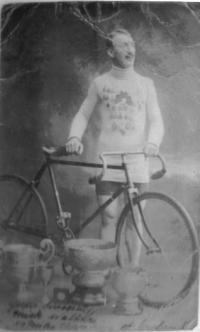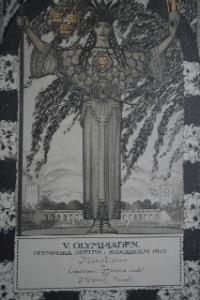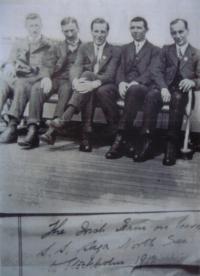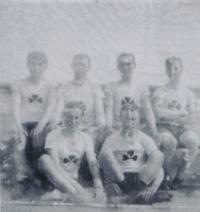Cycling spokes and political strokes
Published in 20th-century / Contemporary History, Features, Issue 4 (July/August 2012), Volume 20
Michael Walker, the top finisher of the six-man cycling team who represented ‘Ireland’ at the 1912 Stockholm Olympics, posing with his Lucania bicycle and the commemorative certificate presented for finishing the race, this one to his brother, John. (Michael Walker Jnr)
Most Irish Olympians up to 1924 were either representatives of adopted homelands, like the USA or the Commonwealth dominions (in 1912 Kennedy McArthur from County Antrim became the only Irish-born winner of the men’s marathon, representing South Africa), or home-based competitors classed in official records as part of the Great Britain team, or sometimes ‘Great Britain and Ireland’. After its foundation in 1906, the British Olympic Association (BOA) assumed total control over the Olympic affiliation of sporting bodies in the United Kingdom and only accepted membership from three Irish organisations, all of them deemed to be of moderate or pro-British political views. As a general rule, the BOA did everything it could to prevent Irish people from representing ‘Ireland’ in any Olympic Games, preferring instead that they would form part of a ‘Great Britain and Ireland’ team.
Three Irish sports bodies affiliated to the BOA
The three Irish sports bodies that were affiliated to the BOA were the Irish Amateur Athletic Association (IAAA), the Irish Cyclists Association (ICA) and the Irish Amateur Swimming Association. No Welsh organisations were included but both the Scottish Amateur Athletic Association and the Scottish Cyclists’ Union were listed. Of the nations within the then United Kingdom, even these moderately political Irish sporting bodies were invariably the ones who most sought separate representation at the Olympic Games. The BOA minutes record, for example, on 25 April 1911, receipt of a letter from the Irish Amateur Athletic Association:
 ‘That the time has now come when the BOA as at present formed should be dissolved, and that the British representatives on the International Olympic Committee should endeavour to obtain separate representation for England, Scotland and Ireland on the committee’.
‘That the time has now come when the BOA as at present formed should be dissolved, and that the British representatives on the International Olympic Committee should endeavour to obtain separate representation for England, Scotland and Ireland on the committee’.
The BOA rejected the efforts of the IAAA to achieve this or any other form of separate Olympic identity in athletics, not least because the Irish athletes were at that time among the very best weight-throwers and jumpers in the world, not just likely to be on a possible Great Britain and Ireland team for the Stockholm Olympics. A very rare exception to this position occurred in 1912, when an Irish Cyclists Association team of six represented ‘Ireland’ at the Stockholm Games. That the BOA did, ultimately, accede to the push for separate Irish and Scottish cycling teams in Stockholm was mainly because separate cycling teams from these countries were unlikely threats to ‘Great Britain’, either in sporting or in political terms.
Separate Irish cycling team for Stockholm allowed
In the end, the BOA minutes show that a separate Irish cycling team for the Stockholm Games was allowed and was supported financially too. A meeting of the BOA on 28 November 1911 reported that:
‘. . . it had been intimated that the Irish Cyclists Association would probably desire to enter a team, and Mr Blair explained that the regulations permitted the entry of teams from England, Scotland and Ireland’.
Some months later, the committee had a further application before it from the Scottish Cyclists’ Union and recommended that the BOA defray the expenses of four Scottish and four Irish competitors, leaving the cycling associations of these countries to provide for any further competitors that they wished to send. The minutes of 16 April 1912 made it clear that the ICA had made an application for such support prior to this, even asking whether the money would be conditional on the ICA’s finding additional funds to make up a full squad of six cyclists, i.e. funding two from their own resources:
‘It was agreed that the grant should be unconditional, but that it should be suggested to the ICA that if at the eliminating trials the team were found to be not likely to do so well as the ICA had expected, it might be well to send only two or three competitors to take part in the individual competition’.

The Irish cycling team relaxing on board the Saga, crossing the North Sea en route to Stockholm in 1912 (Michael Walker is second from left)
Swedish organisers taken by surprise
There is no further explanation in the BOA minutes concerning the association’s decision to support separate English, Irish and Scottish cycling teams for Stockholm. In the end, six ICA cyclists did compete in Stockholm, with the BOA apparently absorbing some of the additional costs. They travelled on a ferry across the North Sea and the remarkable photographic records of one of the six, Michael Walker, show the team relaxing on deck and, in a photo on their return, proudly wearing giant shamrock emblems. More remarkably, the Swedish organisers were taken completely by surprise, it appears, by the arrival of three separate cycling teams when in every other event, as per the BOA’s own regulations, Great Britain had only one recognised team. Quite clearly, the BOA’s interpretation of the rules allowing three different cycling teams from the United Kingdom to participate in the games was not shared by other countries. On the day before the cycling road race, France lodged an objection to what it, and many other nations, regarded as a clear breach of the rules on national representation. The cycling committee noted in the Official Olympic Report for 1912 that they
‘. . . regretted that this concession had been made, but declared at the same time that, as the teams from the countries in question had come to Sweden to take part in the event, the Swedish Cycling Committee did not wish to prevent them from doing so, and that the Swedish Cycling Association intended to take the responsibility for their so doing on its own shoulders, should any steps be taken in the matter by the Union Cycliste Internationale’.

on their return proudly wearing their ICA jerseys with giant shamrock emblems. (Michael Walker Jnr)
Race an endurance test
The cyclists started individually at two-minute intervals, from 2am onwards, and the first Irish cyclist home took over twelve and a half hours to finish. The Irish were unfortunate in that the first Irish cyclist did not start until the 41st time-slot on the schedule, at 3.20am, by which time the weather had turned very much for the worse, with a strong westerly wind blowing directly into the faces of the later starters. The eventual winner, Rudolph Lewis of South Africa, had been the second rider off and clearly benefited from the better conditions early on.The highest-placed Irish cyclist was Michael Walker, in 67th place, with the other five team members occupying places in the last twenty of a total of 91 finishers. Following Walker were Francis Guy (71st), Ralph Mecredy (80th), John Walker (81st), Matthew Walsh (82nd) and Bernard Doyle (85th). This left Ireland with a team position, based on the first four riders home, of eleventh. (Mecredy, by the way, is widely credited with being the inventor of ‘bicycle polo’, and was on the Irish team that beat Germany 3–1 in an exhibition game at the London Olympics in 1908.)The Stockholm race was an endurance test beyond belief. In addition to the 29 who dropped out, 28 riders did not even start the race, at least some of them baulking at the conditions and hardship of the terrain, while only the first three home did so in less than eleven hours. The Irish achievement here was considerable. Their level of support could not have been anywhere near that of other teams, as subsequent correspondence shows that they did not even have spare bicycles if and when anything went wrong en route. All six Irish cyclists finished the race, which is put in perspective by the fact that four of the twelve Swedes failed to finish, even though Sweden won gold, and two of the second-placed England team did not finish either. Only one of the ten Russian competitors in the race actually finished at all, and Ireland’s scoring cyclists meant that our placing was above Hungary, Bohemia, Norway and Russia. So this was no mean achievement, especially for a group of cyclists who, politically, had had to overcome difficulties both within the BOA and in Sweden to be even allowed to participate. After the race, the organisers decided to award special diplomas of merit to the cyclists who had finished within 25% of the winner’s time, resulting in the first four Irish cyclists receiving this additional recognition.
Focus on the bicycles rather than the cyclists
The decline in the fortunes of Irish athletics, even in the four years since London, is mirrored in the decreased coverage of the Stockholm Olympics by the Irish media. The nationalist newspaper Sinn Féin was reduced to a few short paragraphs bemoaning the fact that Irishmen continued to be victorious but only as representatives of foreign states. In fact, the main focus of editor Arthur Griffith’s attention on Stockholm was the opportunity, in its 20 July 1912 edition, to reinforce one of the Sinn Féin party’s central tenets, its buy-Irish campaign, using the aforementioned cyclists:
‘One remarkable record comes to Ireland. In the long distance (team) cycle race, the only team all of whose members finished was the Irish team. Two thirds of its members were mounted on Lucania bicycles—bicycles completely manufactured in Dublin. The riders of the Lucania raced on them for twelve hours in competition with the world . . . In the case of every other team most of the riders had to change bicycles during the progress of the race. The Irish Lucania bicycle had thus made a world’s record. And still in the city in which it is manufactured twenty foreign and inferior machines are purchased to every one of the Irish machines, which beat the world at Stockholm. What slaves and what fools to our own interests we continue to be.’
This marvellous vote of confidence in Irish manufacture, of course, disguised the fact that the Irish cyclists had not been able to bring spare bikes or parts with them in the first place, thus necessitating the repair of their own machines as difficulties arose. It was an interesting final political twist to this particular Irish/Viking saga, but nothing should obscure the magnificent efforts of these intrepid men on two wheels to represent Ireland at a time when Ireland was not recognised in either British, Olympic or world sport. HI
Kevin McCarthy holds a Ph.D in history from University College Cork.
Further reading:
K. McCarthy, Gold, silver and green: the Irish Olympic journey 1896–1920 (Cork, 2010).
















